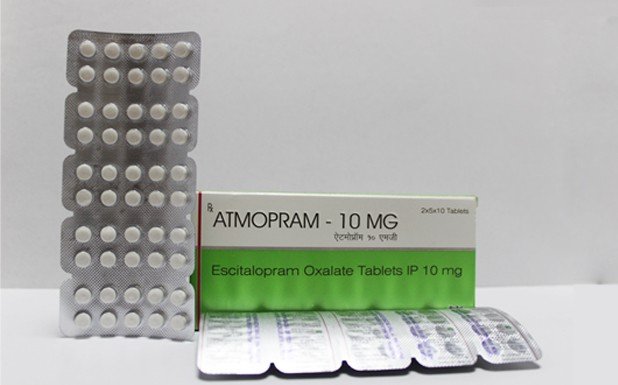
Composition
- Each Film coated Tablet Contains:
- Escitalopram Oxalate IP
10 mg
Packing
- 10x10
(Blister)
MRP
- 65
Overview
Escitalopram is an oral drug that is used for treating depression and generalized anxiety disorder. Chemically, escitalopram is similar to citalopram (Celexa). Both are in a class of drugs called selective serotonin reuptake inhibitors (SSRIs), a class that also includes fluoxetine (Prozac), paroxetine (Paxil) and sertraline (Zoloft). SSRIs work by affecting neurotransmitters in the brain, the chemical messengers that nerves use to communicate with one another. Neurotransmitters are made and released by nerves and then travel to other nearby nerves where they attach to receptors on the nerves. Not all of the neurotransmitter that is released binds to receptors and, instead, is taken up by the nerves that produced them. This is referred to as "reuptake." Many experts believe that an imbalance of neurotransmitters is the cause of depression. Escitalopram prevents the reuptake of one neurotransmitter, serotonin, an action which results in more serotonin in the brain to attach to receptors.
ATMOPRAM is used for
•Treating depression or generalized anxiety disorder. It may also be used for other conditions as determined by your doctor.•Escitalopram is a selective serotonin reuptake inhibitor (SSRI). It works by restoring the balance of serotonin, a natural substance in the brain, which helps to improve certain mood problems.
Warnings
Do not use ATMOPRAM 10MG if:
you are allergic to any ingredient in escitalopram or to citalopram
you have a certain type of irregular heartbeat (long QT syndrome) or uncorrected low blood potassium or magnesium levels
you are taking or have taken linezolid or a monoamine oxidase inhibitor (MAOI) (eg, phenelzine, selegiline) within the last 14 days you are taking pimozide
Contraindications
Monoamine oxidase inhibitors (MAOIs)
Concomitant use in patients taking monoamine oxidase inhibitors (MAOIs) is contraindicatedPimozide
Concomitant use in patients taking pimozide is contraindicatedHypersensitivity to escitalopram or citalopram
Lexapro is contraindicated in patients with a hypersensitivity to escitalopram or citalopram or any of the inactive ingredients in Lexapro.Side Effects
Escitalopram may cause side effects. Tell your doctor if any of these symptoms are severe or do not go away:
nausea
diarrhea
constipation
changes in sex drive or ability
drowsiness
increased sweating
dizziness
heartburn
stomach pain
excessive tiredness
dry mouth
increased appetite
flu-like symptoms
runny nose
sneezing
Dosage
Oral:
Disclaimer:To be taken only after consulting with the doctor.
Storage
Escitalopram should be stored at room temperature, 15 C to 30 C (59 F to 86 F)
Pharmacology
Mechanism of Action
The mechanism of antidepressant action of escitalopram, the S-enantiomer of racemic citalopram, is presumed to be linked to potentiation of serotonergic activity in the central nervous system (CNS) resulting from its inhibition of CNS neuronal reuptake of serotonin (5-HT).Pharmacodynamics
In vitro and in vivo studies in animals suggest that escitalopram is a highly selective serotonin reuptake inhibitor (SSRI) with minimal effects on norepinephrine and dopamine neuronal reuptake. Escitalopram is at least 100-fold more potent than the R-enantiomer with respect to inhibition of 5-HT reuptake and inhibition of 5-HT neuronal firing rate. Tolerance to a model of antidepressant effect in rats was not induced by long-term (up to 5 weeks) treatment with escitalopram. Escitalopram has no or very low affinity for serotonergic (5-HT1-7) or other receptors including alpha- and beta-adrenergic, dopamine (D1-5), histamine (H1-3), muscarinic (M1-5), and benzodiazepine receptors. Escitalopram also does not bind to, or has low affinity for, various ion channels including Na+, K+, Cl-, and Ca++ channels. Antagonism of muscarinic, histaminergic, and adrenergic receptors has been hypothesized to be associated with various anticholinergic, sedative, and cardiovascular side effects of other psychotropic drugs.Pharmacokinetics
The single- and multiple-dose pharmacokinetics of escitalopram are linear and dose-proportional in a dose range of 10 to 30 mg/day. Biotransformation of escitalopram is mainly hepatic, with a mean terminal half-life of about 27-32 hours. With once-daily dosing, steady state plasma concentrations are achieved within approximately one week. At steady state, the extent of accumulation of escitalopram in plasma in young healthy subjects was 2.2-2.5 times the plasma concentrations observed after a single dose. The tablet and the oral solution dosage forms of escitalopram oxalate are bioequivalent.Absorption and Distribution: Following a single oral dose (20 mg tablet or solution) of escitalopram, peak blood levels occur at about 5 hours. Absorption of escitalopram is not affected by food.
The absolute bioavailability of citalopram is about 80% relative to an intravenous dose, and the volume of distribution of citalopram is about 12 L/kg. Data specific on escitalopram are unavailable.
The binding of escitalopram to human plasma proteins is approximately 56%.
Metabolism and Elimination: Following oral administrations of escitalopram, the fraction of drug recovered in the urine as escitalopram and S-demethylcitalopram (S-DCT) is about 8% and 10%, respectively. The oral clearance of escitalopram is 600 mL/min, with approximately 7% of that due to renal clearance.
Escitalopram is metabolized to S-DCT and S-didemethylcitalopram (S-DDCT). In humans, unchanged escitalopram is the predominant compound in plasma. At steady state, the concentration of the escitalopram metabolite S-DCT in plasma is approximately one-third that of escitalopram. The level of S-DDCT was not detectable in most subjects. In vitro studies show that escitalopram is at least 7 and 27 times more potent than S-DCT and S-DDCT, respectively, in the inhibition of serotonin reuptake, suggesting that the metabolites of escitalopram do not contribute significantly to the antidepressant actions of escitalopram. S-DCT and S-DDCT also have no or very low affinity for serotonergic (5-HT1-7) or other receptors including alpha- and beta-adrenergic, dopamine (D1-5), histamine (H1-3), muscarinic (M1-5), and benzodiazepine receptors. S-DCT and S-DDCT also do not bind to various ion channels including Na+, K+, Cl-, and Ca++ channels.
In vitro studies using human liver microsomes indicated that CYP3A4 and CYP2C19 are the primary isozymes involved in the Ndemethylation of escitalopram.